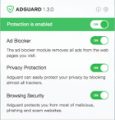What is ProgressElemnt
According to security professionals, ProgressElemnt is a PUP (potentially unwanted program) that belongs to the Adware family . Adware is form of malicious software which presents unwanted advertising on a MAC, redirects search requests to advertising web sites and gathers sensitive info for marketing purposes. Adware software can show banner advertisements, full-screen ads, pop-ups, videos, or other varieties of online advertising. Adware can attack your MAC system’s web browsers like the Firefox, Chrome and Safari. Maybe you approve the idea that the ads or pop ups is just a small problem. But these intrusive advertisements eat machine resources and slow down your MAC OS performance.
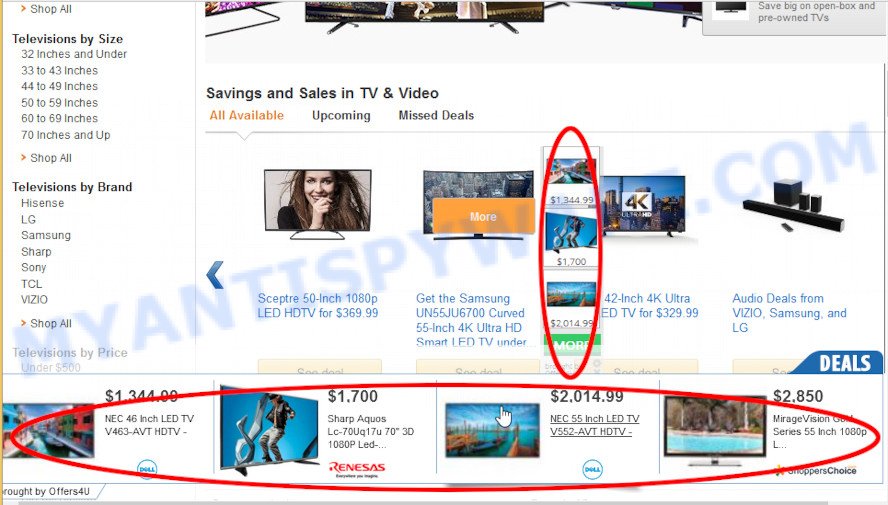
Unwanted ads
The worst is, adware can be used to collect lots of marketing-type data about you (your ip address, what is a website you are viewing now, what you are looking for on the Net, which links you are clicking), which can later transfer to third parties.
By following steps below it is easy to scan and remove adware from Chrome, Safari and Mozilla Firefox and your computer. Learn how to get rid of ProgressElemnt and adware apps, as well as how to run a full machine virus scan.
How does ProgressElemnt get on your MAC
The most popular way to get adware is a freeware setup package. In many cases, a user have a chance to disable all bundled web-browser extensions, but some setup files are designed to confuse the average users, in order to trick them into installing PUPs and adware software. Anyway, easier to prevent adware rather than clean up your MAC system after one. So, keep your internet browser updated (turn on automatic updates), run good antivirus software, double check free software before you open it (do a google search, scan a downloaded file with VirusTotal), avoid dubious and unknown web-pages.
Threat Summary
| Name | ProgressElemnt, ProgressElemnt 1.0 app |
| Type | adware software, potentially unwanted application (PUA), pop-up ads, pop-up virus, pop-ups |
| Symptoms |
|
| Removal | ProgressElemnt removal guide |
How to remove ProgressElemnt from Mac
We can assist you remove ProgressElemnt ads from your web browsers, without the need to take your machine to a professional. Simply follow the removal guide below if you currently have the intrusive adware on your computer and want to delete it. If you have any difficulty while trying to get rid of the ProgressElemnt , feel free to ask for our help in the comment section below. Read this manual carefully, bookmark it or open this page on your smartphone, because you may need to close your web browser or restart your MAC.
To remove ProgressElemnt, complete the steps below:
- Remove unwanted profiles on Mac device
- Delete ProgressElemnt related apps through the Finder
- Remove ProgressElemnt related files and folders
- Scan your Mac with MalwareBytes
- Remove ProgressElemnt from Safari, Chrome, Firefox
- How to stay safe online
- To sum up
Remove unwanted profiles on Mac device
ProgressElemnt can install a configuration profile on the Mac system to block changes made to the browser settings. Therefore, you need to open system preferences, find and delete the profile installed by the adware.
Click the System Preferences icon ( ![]() ) in the Dock, or choose Apple menu (
) in the Dock, or choose Apple menu ( ![]() ) > System Preferences.
) > System Preferences.
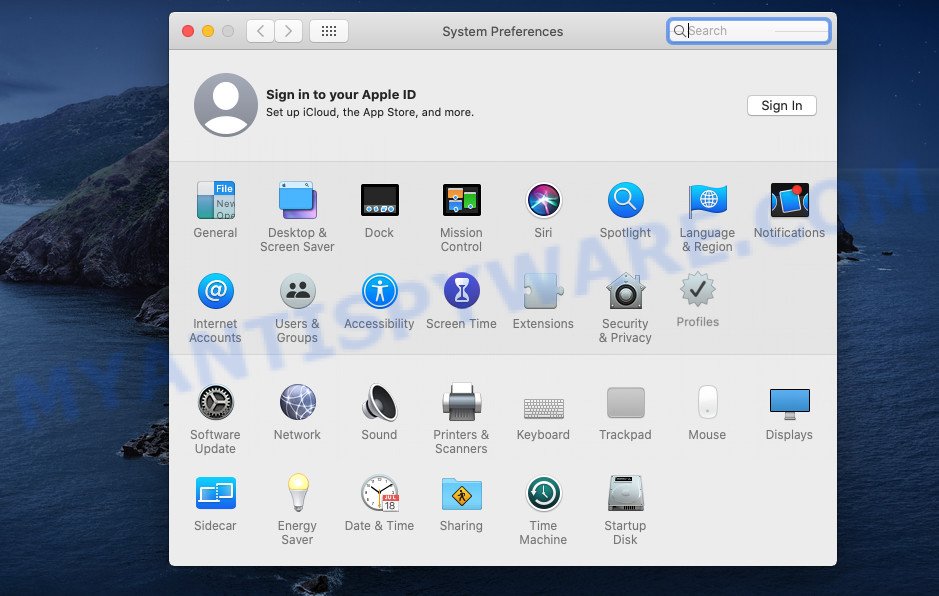
In System Preferences, click Profiles, then select a profile associated with ProgressElemnt.
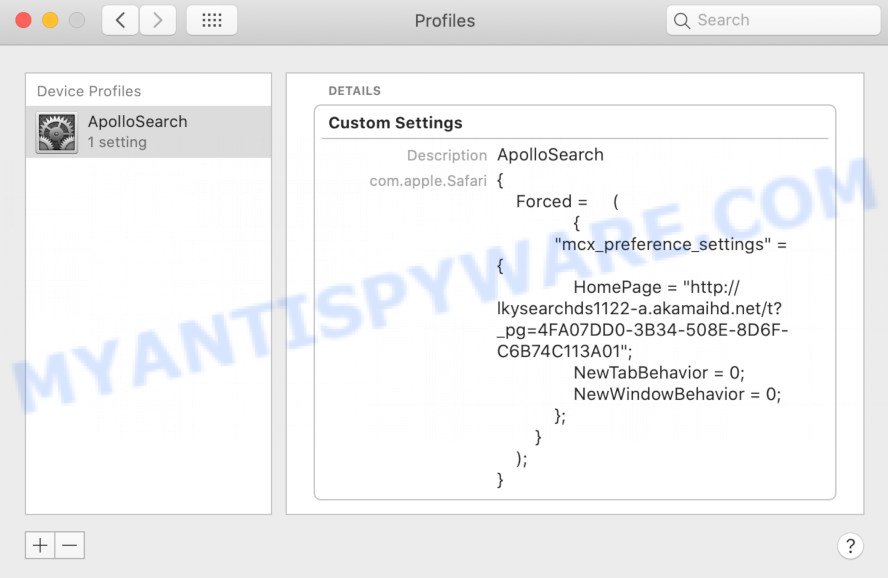
Click the minus button ( – ) located at the bottom-left of the Profiles screen to remove the profile.
Note: if you do not see Profiles in the System Preferences, that means there are no profiles installed on your Mac device, which is normal.
Delete ProgressElemnt related apps through the Finder
Some adware, browser hijackers and PUPs can be deleted by uninstalling the free applications they came with. If this way does not succeed, then looking them up in the list of installed apps in the Finder. Use the “Move to Trash” command in order to remove them.
Open Finder and click “Applications”.
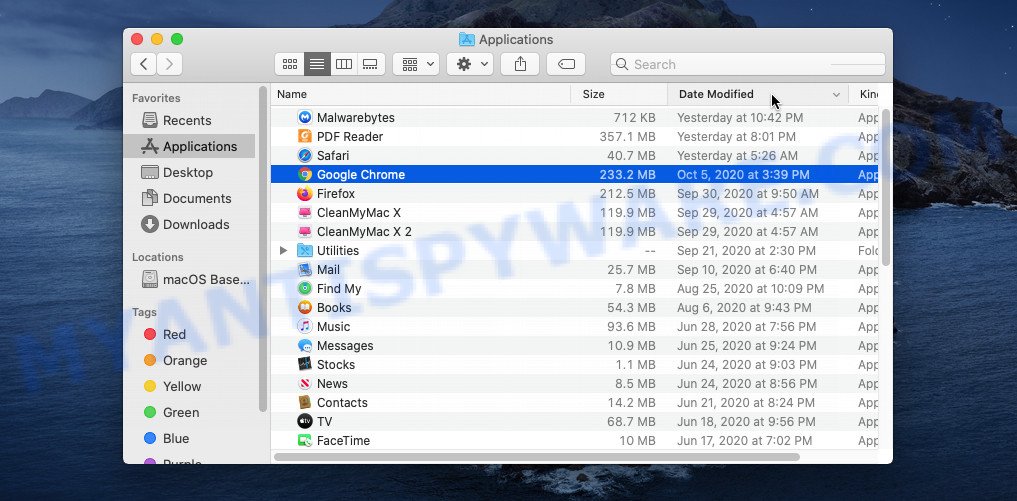
Very carefully look around the entire list of applications installed on your computer. Most likely, one of them is the ProgressElemnt adware. Once you’ve found a dubious, unwanted or unused program, right click to it and choose “Move to Trash”. Another method is drag the program from the Applications folder to the Trash.
Don’t forget, choose Finder -> “Empty Trash”.
Remove ProgressElemnt related files and folders
Now you need to try to find ProgressElemnt related files and folders, and then delete them manually. You need to look for these files in certain directories. To quickly open them, we recommend using the “Go to Folder…” command.
Click on the Finder icon. From the menu bar, select Go and click “Go to Folder…”. As a result, a small window opens that allows you to quickly open a specific directory.

Check for ProgressElemnt generated files in the /Library/LaunchAgents folder

In the “Go to Folder…” window, type the following text and press Go:
/Library/LaunchAgents
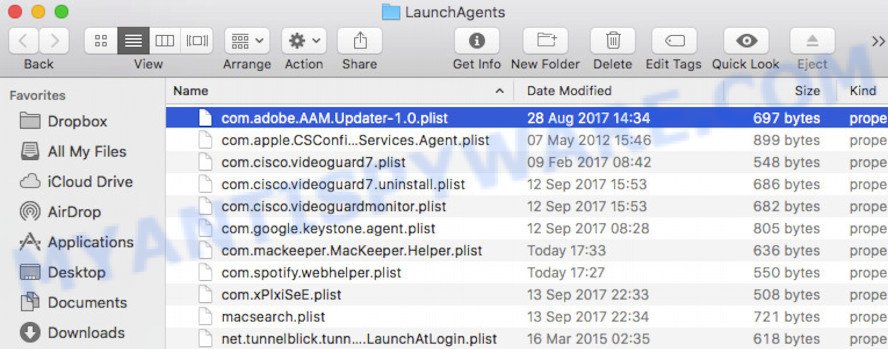
This will open the contents of the “/Library/LaunchAgents” folder. Look carefully at it and pay special attention to recently created files, as well as files that have a suspicious name. Move all suspicious files to the Trash. A few examples of files: macsearch.plist, installapp.plist, ProgressElemnt.plist, search.plist and com.machelper.plist. Most often, adware, potentially unwanted programs and browser hijackers create several files with similar names.
Check for ProgressElemnt generated files in the /Library/Application Support folder

In the “Go to Folder…” window, type the following text and press Go:
/Library/Application Support
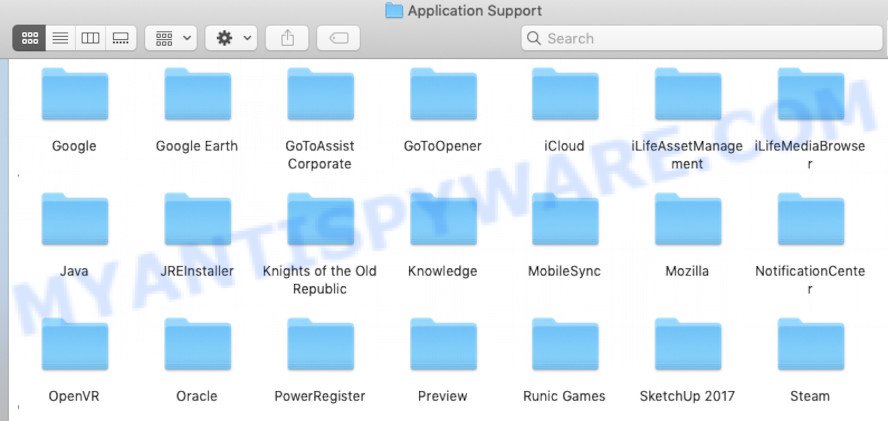
This will open the contents of the “Application Support” folder. Look carefully at its contents, pay special attention to recently added/changed folder. Move all suspicious folders to the Trash.
Check for ProgressElemnt generated files in the “~/Library/LaunchAgents” folder

In the “Go to Folder…” window, type the following text and press Go:
~/Library/LaunchAgents

Proceed in the same way as with the “/Library/LaunchAgents” and “/Library/Application Support” folders. Look for suspicious and recently added files. Move all suspicious files to the Trash.
Check for ProgressElemnt generated files in the /Library/LaunchDaemons folder
In the “Go to Folder…” window, type the following text and press Go:
/Library/LaunchDaemons

Carefully browse the entire list of files and pay special attention to recently created files, as well as files that have a suspicious name. Move all suspicious files to the Trash. A few examples of files to be deleted: com.macsearch.plist, com.installapp.plist, com.machelper.plist, com.search.plist and com.ProgressElemnt.plist. In most cases, potentially unwanted programs, adware software and browser hijackers create several files with similar names.
Scan your Mac with MalwareBytes
We advise using MalwareBytes Anti-Malware. You can download and install MalwareBytes Anti-Malware to look for and get rid of ProgressElemnt related programs from your Mac. When installed and updated, the malware remover automatically identifies and removes all security threats exist on the computer.
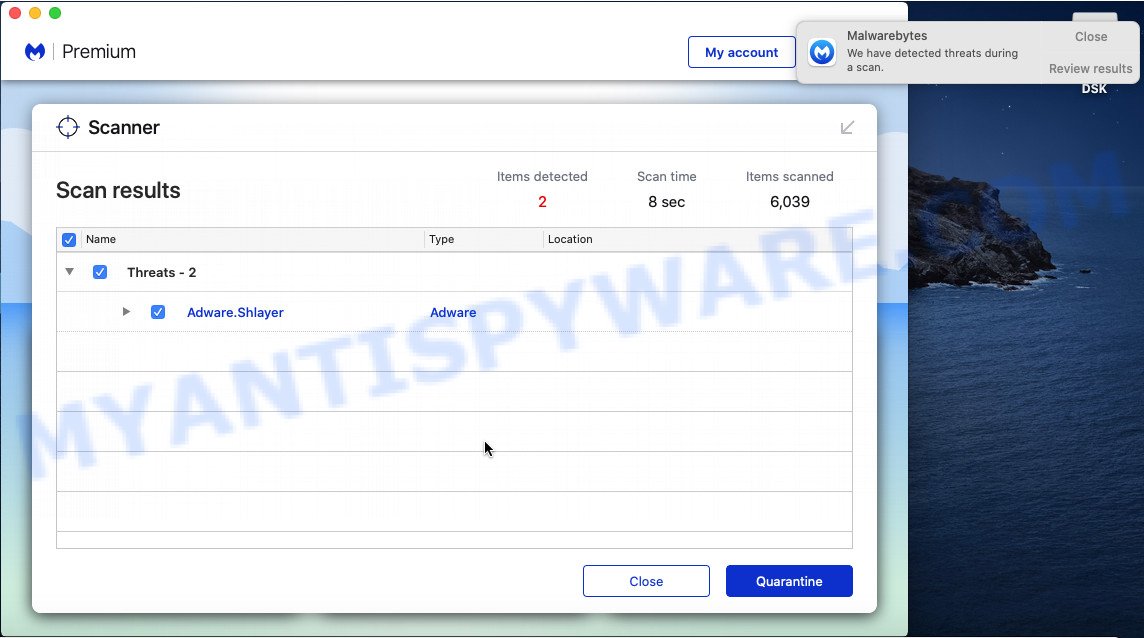
- MalwareBytes AntiMalware (MBAM) can be downloaded from the following link.
Malwarebytes Anti-malware (Mac)
21174 downloads
Author: Malwarebytes
Category: Security tools
Update: September 10, 2020
- When downloading is done, please close all software and open windows on your MAC. Run the downloaded file. Follow the prompts.
- The MalwareBytes Free will start and open the main window.
- Further, click the “Scan” button to search for ProgressElemnt adware. A scan can take anywhere from 10 to 30 minutes, depending on the count of files on your machine and the speed of your machine. During the scan MalwareBytes Anti Malware (MBAM) will scan for threats exist on your computer.
- When MalwareBytes is finished scanning your MAC system, MalwareBytes Anti-Malware (MBAM) will show a list of detected items.
- In order to delete all threats, simply press the “Remove Selected Items” button.
- Close the Anti Malware and continue with the next step.
Remove ProgressElemnt from Safari, Chrome, Firefox
Remove unwanted add-ons is a simple way to remove ProgressElemnt and return web browser’s settings that have been changed by adware.
You can also try to remove ProgressElemnt adware software by reset Google Chrome settings. |
If you are still experiencing issues with ProgressElemnt adware removal, you need to reset Firefox browser. |
|
How to stay safe online
One of the worst things is the fact that you cannot block all malicious webpages using only built-in Windows capabilities. However, there is a program out that you can use to block unwanted browser redirections, advertisements and popups in any modern internet browsers including Firefox, Chrome and Safari. It’s named Adguard and it works very well.
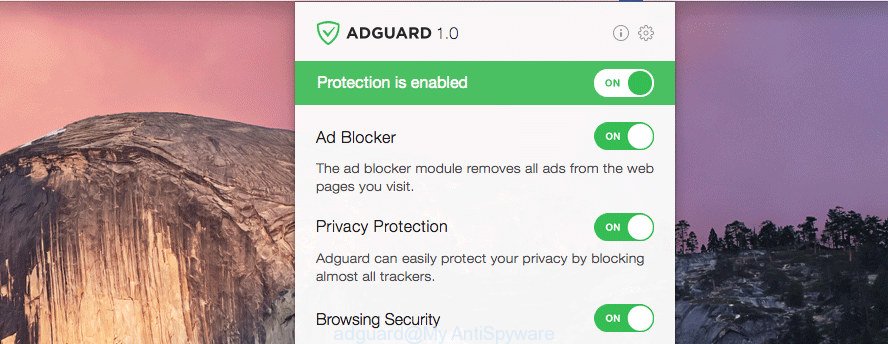
Installing the AdGuard is simple. First you’ll need to download AdGuard from the link below. Save it on your Microsoft Windows desktop.
3886 downloads
Author: © Adguard
Category: Security tools
Update: January 17, 2018
When downloading is finished, start the downloaded file. You will see the “Setup Wizard” screen. Follow the prompts.
Each time, when you run your MAC OS, AdGuard will launch automatically and stop annoying popup advertisements, block harmful and misleading web-pages.
To sum up
Now your machine should be free of the ProgressElemnt adware software. We suggest that you keep AdGuard (to help you block unwanted pop up advertisements and intrusive harmful websites) and MalwareBytes Free (to periodically scan your Apple Mac for new malware, browser hijackers and adware). Make sure that you have all the Critical Updates recommended for Mac operating system. Without regular updates you WILL NOT be protected when new browser hijackers, malicious software and adware are released.
If you are still having problems while trying to delete ProgressElemnt ads from your internet browser, then ask for help here.

